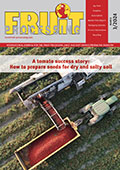While the COVID-19 pandemic has tested the apple industry up and down the supply chain, it has also presented unique opportunities, according to a new report released by the U.S. Apple Association at the organization’s 126th annual Outlook Conference. Considering these opportunities, and despite a challenging 18 months, apple production is expected to exceed 11 billion pounds this crop year.
USApple’s “Industry Outlook 2021” provides the most up-to-date data and analysis on U.S. and global apple production, utilization and trade. Authored by USApple Director of Industry Analytics Chris Gerlach, the report takes an in-depth look at the many trends and forces – from H-2A labor issues to online grocery shopping – helping to shape the U.S. apple industry.
Production
According to a USApple analysis of Agriculture Department data, total U.S. apple production for the 2021-22 crop year will exceed 11.1 billion pounds or 265.4 million bushels. This represents a 2.7 percent increase compared to 2020-21 crop year production of 258.6 million bushels and is 1.3 percent less than the five-year production average.
Gerlach noted that these figures are more comprehensive than USDA data, which only looks at the top seven apple-producing states. “We’ve analyzed the production from states outside of the top seven and added that back to USDA’s figure,” explained Gerlach.
At the varietal level, Gala is expected to retain the top spot with almost 49.3 million bushels produced, accounting for around 19 percent of the U.S. apple market. Rounding out the top five are Red Delicious (35.7 m bu), Honeycrisp (31 m bu), Fuji (29.1 m bu) and Granny Smith (27.2 m bu). In comparison, the 2020 top five produced apple varieties were: 1) Gala 2) Red Delicious 3) Fuji 4) Honeycrisp and 5) Granny Smith.
Trade
With respect to fresh apple imports and exports, the U.S. still retains a healthy positive trade balance. In the 2020-21 crop year. the U.S. exported almost 41 million bushels of fresh apples while only importing around 5.2 million bushels. These net exports (35.6 m bu) are valued at almost $773.8 million.
“On a year-over-year basis, while the balance of trade has declined with respect to quantity, it has increased in value,” said Gerlach. “This is primarily being caused by a rapid decline in the value of imports from the 2019-20 crop year, but is also due to some resilience in export values which have not decreased as much relative to export quantities.”
Labor
“Any assessment of the U.S. apple industry must consider the agricultural employment situation,” said Gerlach. “We are losing domestic workers faster than we can replace them and so, increasingly, growers have had to turn to seasonal migrant labor, or H-2A workers, to meet their needs.”
This is a critical issue for the U.S. apple industry because this source of labor is expensive and getting more so. In the Pacific Northwest, for example, the Adverse Effect Wage Rate (AEWR), the minimum compensation rate for H-2A labor, has been increasing by more than 5 percent annually for the last 10 years.
From 2014 to 2020, average annual crop production employment fell by 3 percent and, in apple orchards specifically, it declined by 20 percent.
Consumer Trends
“Fortunately, throughout the disruptions brought on by COVID-19, the U.S. apple industry has not seen any considerable decrease in domestic demand,” said Gerlach.
Throughout the pandemic, apple packers and marketers have been quick to respond by offering bagged apples that give consumers added peace of mind by reducing the handling needed to stock and pick the fruit. Also, notes Gerlach, the most significant consumer trend to come out of the pandemic was the rate at which shoppers embraced e-commerce grocery shopping, which also aided the sale of apples. By the first quarter of 2021, e-commerce had grown to account for 3.5 percent of food and beverage store sales at $6.9 billion (up from $1.5 billion in Q1 of 2018 – an increase of more than 377 percent).
“All of these external forces, from labor costs to consumer grocery trends, will continue to shape apple production and utilization throughout the coming years,” said Gerlach.
Smurfit Kappa has launched a new range of eBottle packaging solutions for the rapidly growing online beverage and liquids market. The new portfolio includes a variety of sustainable solutions for single and multi-pack products, including the Rollor bottle pack, BiPack, and Pop-up insert.
The surge in e-commerce due to the Covid-19 pandemic is evident across all sectors and the beverage market has also seen a significant impact. In particular, online sales for alcoholic beverages has increased by 34 % in Europe driving a demand for sustainable, durable and consumer friendly packaging that protects the product during shipment.
Key challenges for the beverage e-commerce channel are product damage, sustainability, consumer experience and the ability to accelerate growth using the right packing processes. Consumer research carried out by Smurfit Kappa also shows consumers are continuing to push for higher standards.
The research found :
- Over two thirds (69 %) of consumers prefer paper-based packaging
- Over half (59 %) of consumers want the parcel to be easy to open
- 1 in 10 consumers will reconsider re-ordering in the case of damage
Commenting on the announcement, Arco Berkenbosch, VP Innovation and Development at Smurfit Kappa Europe said: “Our new eBottle product range offers beverage businesses a suite of fit-for-purpose and bespoke packaging solutions which address the key challenges for their e-commerce channel. The innovative range, combined with our focus on e-commerce processes, supply chain and consumer experience, have all contributed to increased sales and greater efficiencies for our customers.”
Smurfit Kappa also offers a host of automated solutions to optimise packaging processes in addition to the eBottle range. The launch of this new product portfolio is the latest addition to its range of Better Planet Packaging, designed to be more sustainable and coming from a renewable and recyclable raw material. Businesses are already benefitting in the alcoholic beverage segment.
InterDrinks is an eMerchant selling more than 2,500 different types of beers and beer products. Smurfit Kappa introduced a flexible and unique packaging solution that accommodates all the various sized products sold by InterDrinks. It also includes automated assembly that mounts the packs as required.
Herwin Wichers, Market Development Director at Smurfit Kappa said: “The online European alcohol beverage market is worth EUR 5.6 billion and we want to help companies take advantage of the real growth and opportunity in this segment. As a result of the implemented packaging and automation solution by InterDrinks, it has increased its packing and filling capacity by 66 %, allowing it to fulfill more orders, faster.”
The future of Asia-Pacific’s retail landscape will force a fundamental change in the way Asian companies are structured, managed and do business. The region is innovating in a new direction towards a future that suits its own aspirations and needs—and retail technology is leading that innovation. Asia-Pacific is also changing the framework and focus of globalisation, and that role will only increase.
In Mintel’s new whitepaper, ‘New Retail: The Futurenomics of Asia-Pacific’, Matthew Crabbe, Regional Trends Director, Asia-Pacific, combines Mintel’s latest research to paint a picture of what the future will look like for the economy, based on existing trends and trajectories in ‘new retail’, and its influences already being felt across the region.
‘New Retail: The Futurenomics of Asia-Pacific’ is broken down into four key discussion points, summarised below by Matthew Crabbe, Regional Trends Director, Asia-Pacific:
Digitisation: Futurenomics nears critical mass
“E-commerce growth is fast-moving and on a massive scale. According to Mintel estimates, e-commerce spending across Asia-Pacific* will increase from 3.6 % of total retail spending in 2010 to 31.4 % by 2020. What’s more, from 2015 to 2025, e-commerce will rise in value by over 290 %, and reach well over 37 % of total retail value across Asia-Pacific*. This growth has created a new critical mass with the convergence of online and offline retail and services into ‘new retail’.
“The online economy is a crucial part of Asia-Pacific’s current and future economic growth. It is also a major part of the continuing integration of the economies and consumer spending patterns across the region. Meanwhile, Asia is not just innovating within ‘new retail’, it is also a hothouse of innovation in artificial intelligence, application of augmented and virtual reality, revolutionary concepts in food production, among many others. And ‘new retail’ is the focus of how all these developments are agglomerating to shape the ‘futurenomics’ of Asia.”
Integration: The value of experience
“‘New retail’ is a process, rather than a market, where the ‘space’ of e-commerce increasingly integrates with physical shopping spaces. It is also a part of a wider integration process into the broader digital consumer services environment, and across all consumer product sectors. Places and processes for shopping are integrating with entertainment, travel and socialising—which is great as a third (32 %) of urban Thai consumers say they are spending more on leisure and entertainment in 2018.
“Brands are finding that they are being drawn into their own integration across sectors. Services brands are merging with retailers; retailers are becoming hoteliers; online platforms are becoming transportation provides—everything is mixing up. This means that brands must now engage with consumers across formats, platforms, technologies, locations, nations and sectors, and find relevance across more aspects of consumer lifestyles.”
Consolidation: More people in less space
“Asia-Pacific’s population is rapidly urbanising into some of the world’s largest cities, creating the potential for ‘new retail’ to develop faster in the region. In India, a quarter (25 %) of urban internet users who shop for groceries do so from online supermarkets at least once a month. Meanwhile, in Indonesia, over half (56 %) of urban smartphone owners have made a purchase through an online retail site or app.
“Urbanisation is likely to be significantly influenced in the future. To meet the needs of vast, crammed populations of tomorrow, cities will have to adapt to new technology. ‘New retail’, with the ability to reach anyone, anywhere, via their smartphones, offers a unique solution to connecting with consumers. Companies in the ‘new retail’ industry are encouraged to spread their influence across the region. In fact, ‘new retail’ is already expanding rapidly across the region through the influence of China’s leading operators.”
Migration: From brawn to ‘e-brain’
“As Asia-Pacific’s populations get older, there will be an increasing need for greater productivity as ‘working age’ populations shrink. This will drive the need for ongoing education and long-life learning to keep up with and adapt to new technologies. Mintel research reveals that as many as three in four (72 %) urban Thai consumers say they want to learn a new skill, while three in five (59 %) urban Chinese mums agree that early education should start as early as possible.
“Technology in production—manufacturing and agriculture, for instance—is leading to a shift from a ‘brawn economy’ to ‘brain economy’. Already new technology has democratised the means of production. In an environment where ideas become currency, we see the emergence of what is now known as the ‘Fifth Estate’. It is where outlier, disruptor and social groupings become instigators of change in mainstream society. ‘New retail’ will be the foundation upon which new economies will be built, and Asia-Pacific is leading the first wave.” Concluded Crabbe.
*Asia-Pacific estimates are based on the following markets: Australia, China, India, Indonesia, Japan, South Korea and Vietnam









